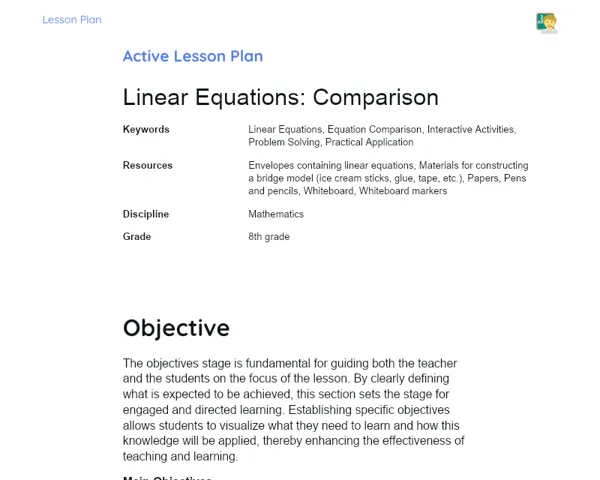Lesson Plan | Lesson Plan Tradisional | Absolute Value and Modulus
| Keywords | Absolute Value, Modulus, Distance on the Number Line, Properties of Absolute Value, Algebraic Expressions, Calculation of the Modulus, Mathematics, 1st Year of High School, Student Engagement, Practical Applications |
| Resources | Chalkboard and Chalk or Whiteboard and Markers, Multimedia Projector (optional), Calculators, Notebooks and Pens for Note-taking, Exercise Sheets with Problems on Absolute Value, Mathematics Textbook |
Objectives
Duration: 10 to 15 minutes
This step aims to lay out clear and specific learning objectives for the students. This helps them understand what is expected of them to learn during the lesson. By outlining the objectives, the teacher can focus the students' attention on the key concepts being taught, making it easier for them to grasp and retain the content.
Objectives Utama:
1. Differentiate the absolute value of a number from its actual value.
2. Calculate the absolute value of different numbers and algebraic expressions.
Introduction
Duration: 10 to 15 minutes
The intention here is to engage the students and spark their interest in learning. By providing context and real-world applications, the teacher helps students see the relevance of what they’re learning, fostering a connection with the subject and enhancing their engagement.
Did you know?
Did you know that absolute value is frequently used in programming and data science? For instance, when measuring the discrepancy between predicted and actual values in predictive models, absolute value helps in accurately quantifying errors. Additionally, in finance, it’s used to measure the volatility and risk associated with investments.
Contextualization
To kick off our discussion on absolute value and modulus, let’s relate these concepts to day-to-day life. The absolute value of a number indicates its distance from zero on the number line, irrespective of its sign. This idea is crucial in many fields, including mathematics, physics, and engineering, where the size of a quantity is often more important than its direction or sign.
Concepts
Duration: 60 to 70 minutes
This segment aims to provide students with a thorough and practical understanding of absolute value and modulus. By covering specific topics and working through practical questions, the teacher helps students apply theoretical concepts to real-life problems, thereby solidifying their knowledge and preparing them to use these techniques in more complex scenarios.
Relevant Topics
1. Definition of Absolute Value: The absolute value of a number refers to its distance from zero on the number line, not taking the sign into account. For example, the absolute value of -5 is 5, and similarly, the absolute value of 5 is also 5. We use the notation |x| to denote the absolute value of x.
2. Properties of Absolute Value: Discuss the main properties of absolute value, which include: |a| >= 0 for any real number a; |a| = a if a >= 0; |a| = -a if a < 0; and |a * b| = |a| * |b|. Talk about how these properties can be applied in various mathematical scenarios.
3. Calculation of the Modulus of Numbers and Algebraic Expressions: Show how to compute the modulus, or absolute value, for numbers and algebraic expressions. Provide practical examples such as |3| = 3, |-7| = 7, and |x - 2|. Solve these problems step by step to clarify how to determine absolute values in each case.
To Reinforce Learning
1. What is the absolute value of -12 and 8?
2. For the algebraic expression |x - 5|, find its value when x = 3 and x = 7.
3. If |a| = 10 and |b| = 4, what is the value of |a * b|?
Feedback
Duration: 20 to 25 minutes
This part serves to review and reinforce the knowledge gained during the lesson. Engaging with the questions and encouraging interaction among students creates an active learning environment where they can clarify their doubts and deepen their comprehension.
Diskusi Concepts
1. The absolute value of -12 is 12, as it only considers the distance to zero on the number line, disregarding the sign. Likewise, the absolute value of 8 is 8. 2. To solve the expression |x - 5|, replace x with the given values: For x = 3, |3 - 5| = |-2| = 2; and for x = 7, |7 - 5| = |2| = 2. 3. Given |a| = 10 and |b| = 4, the product |a * b| is |10 * 4| = |40| = 40. Explain that the absolute value of the product equals the product of the absolute values.
Engaging Students
1. Pose the question: 'Why is the absolute value of any number non-negative?' 2. Encourage students to discuss the relevance of calculating absolute values in various contexts like physics or programming. 3. Challenge students to evaluate the expression |x + 3| when x = -5 and x = 2. Then review their answers together. 4. Ask them: 'How can you use the properties of absolute value to simplify algebraic expressions?'
Conclusion
Duration: 10 to 15 minutes
The goal of this concluding segment is to revisit and solidify the key concepts covered during the lesson, ensuring students leave with a cohesive understanding of the material. By summarizing and linking theory to real-world applications, the lesson reinforces the significance of the topic and its relevance in daily life.
Summary
['The definition of absolute value as the distance from zero on the number line, without regard to sign.', 'Key properties of absolute value, like |a| >= 0, |a| = a if a >= 0, |a| = -a if a < 0, and |a * b| = |a| * |b|.', 'Methods for calculating the modulus of numbers and algebraic expressions, with examples including |3| = 3, |-7| = 7, and |x - 2|.']
Connection
Throughout the lesson, the theoretical concepts of absolute value and modulus were connected to practical applications through relevant examples and systematic problem-solving. This approach helped students see how these concepts apply in various situations, including solving algebraic expressions and applications in programming and finance.
Theme Relevance
Grasping the concept of absolute value is vital not just for mathematics but also for various other fields like physics, engineering, and data science. For instance, when assessing the difference between predicted and actual values, absolute value is critical for accurately quantifying errors. In finance, it serves to gauge investment risks and volatilities, showcasing its widespread significance.



